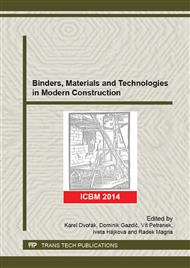p.174
p.178
p.185
p.189
p.193
p.197
p.202
p.207
p.211
The Study of Washed Recycled Concrete Aggregates and Blast Furnace Slag Utilization in Concrete Production
Abstract:
This contribution is focused on re-use of different types of industrial raw-wastes in concrete production. From examined wastes, blast-furnace slag and washed recycled concrete were prepared our tested concrete samples with dimension 150 mm. In these samples were fraction 0-4 mm replacement by blast-furnace slag with a range of variation from 0 to 100%. Fraction 4-8 mm and 8-16 mm were replacement by aggregate prepared from washed recycled concrete parts with a range of variation from 0 to 100% in both fractions. Concrete samples contained aggregate prepared form recycled concrete and blast-furnace slag, are tested after 14 and 28 days of hardening.
The highest value of compressive strength after 14 days (25.2 MPa) and 28 days of hardening (32.3 MPa) reached sample, which contained 20% of blast furnace slag as a substitute for natural aggregate in fraction 0/4 mm. Compressive strength of this sample is the same kind of reached a comparative sample. Lowest value of compressive strength after 14 and 28 days of hardening reached a sample, which contained 30% blast-furnace slag fraction 0-4 mm, and 100% aggregate prepared from recycled concrete fraction 4-8 and 8-16 mm. Before wider using of these selected wastes, another properties as a durability and corrosion are necessary to investigate.
Info:
Periodical:
Pages:
197-201
Citation:
Online since:
April 2015
Authors:
Price:
Сopyright:
© 2015 Trans Tech Publications Ltd. All Rights Reserved
Share:
Citation:


